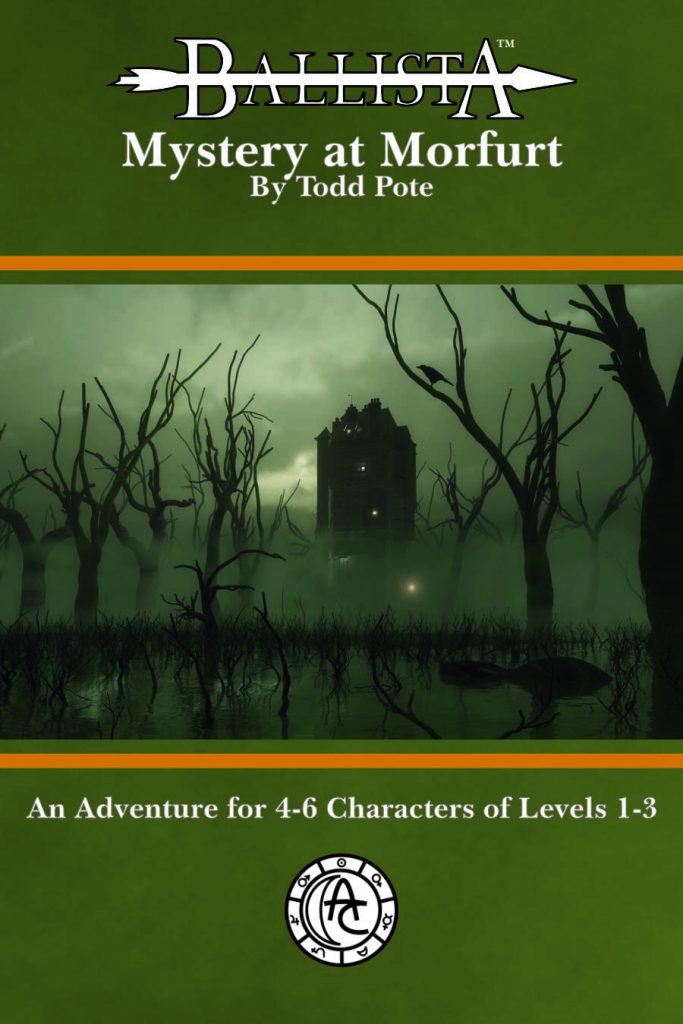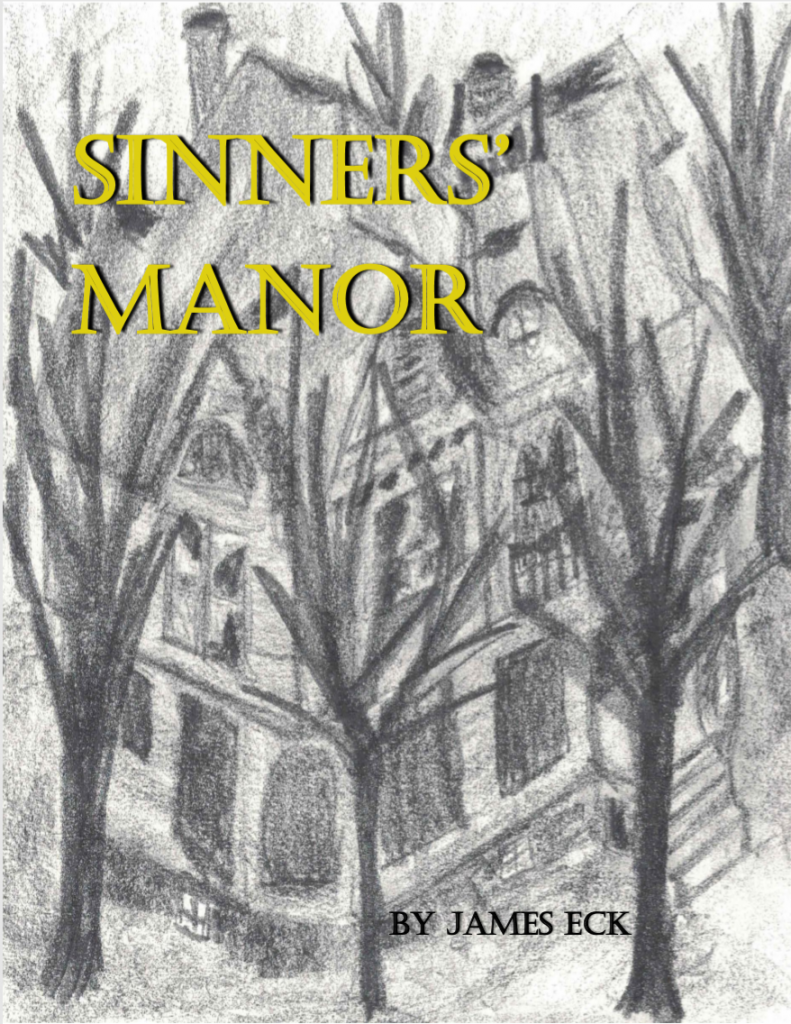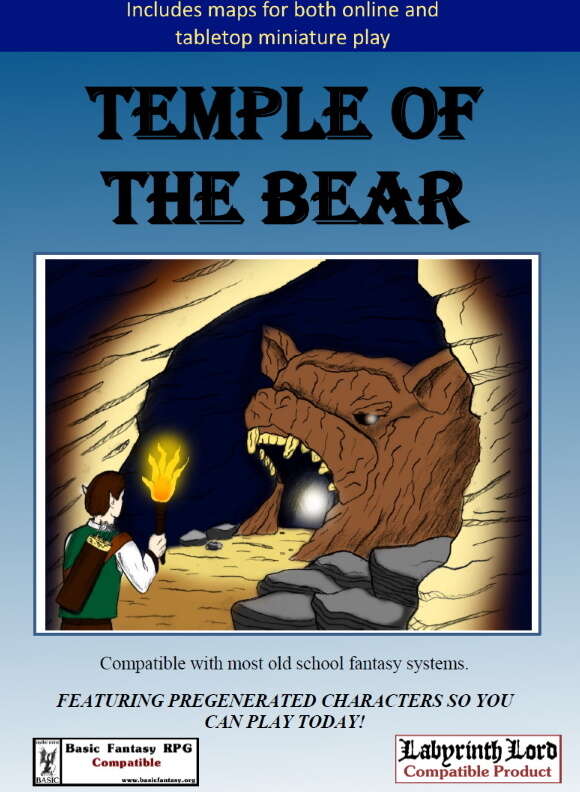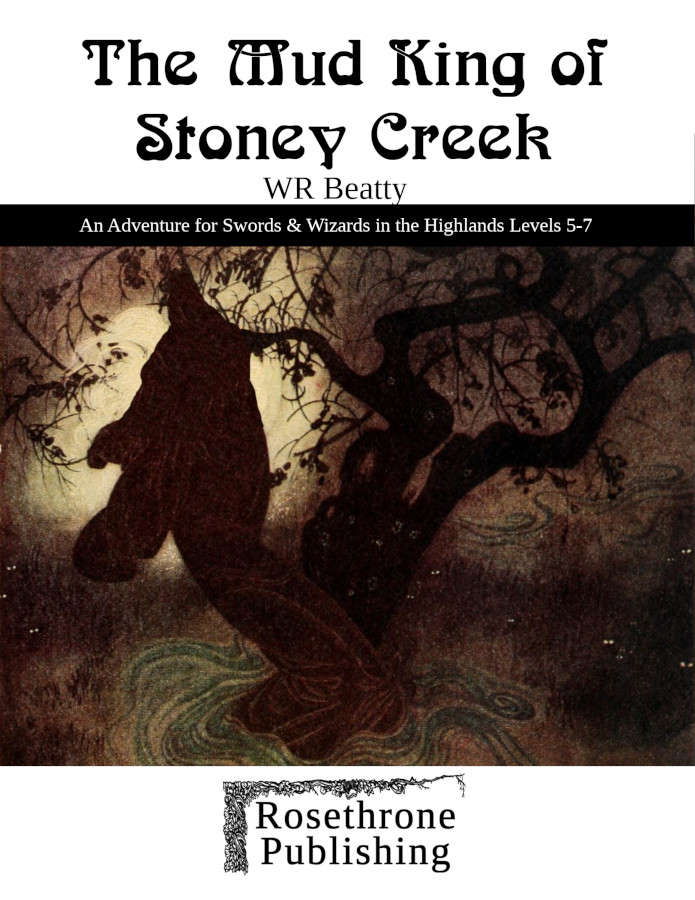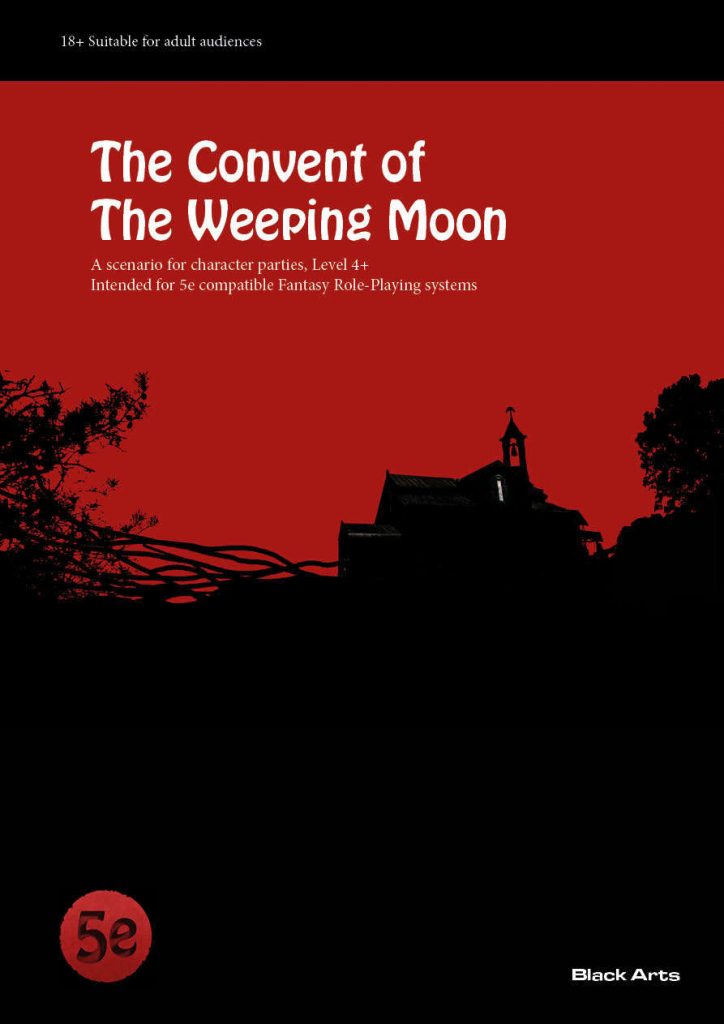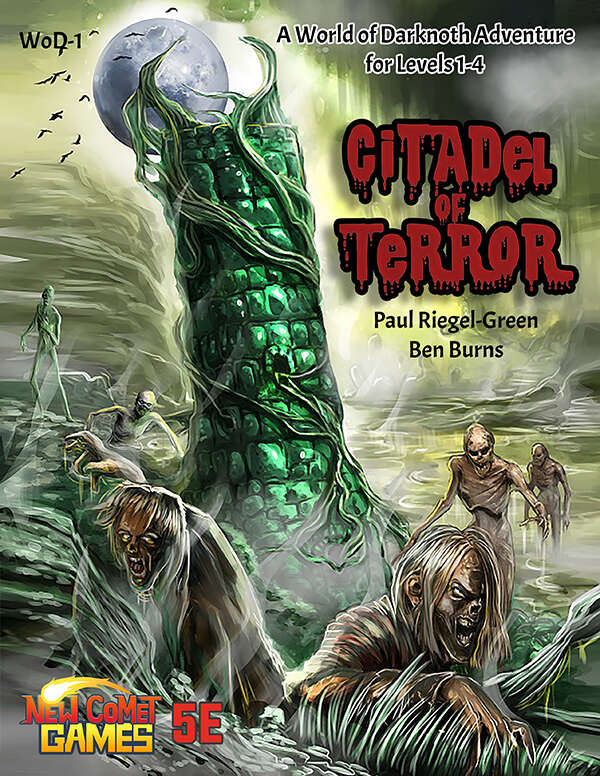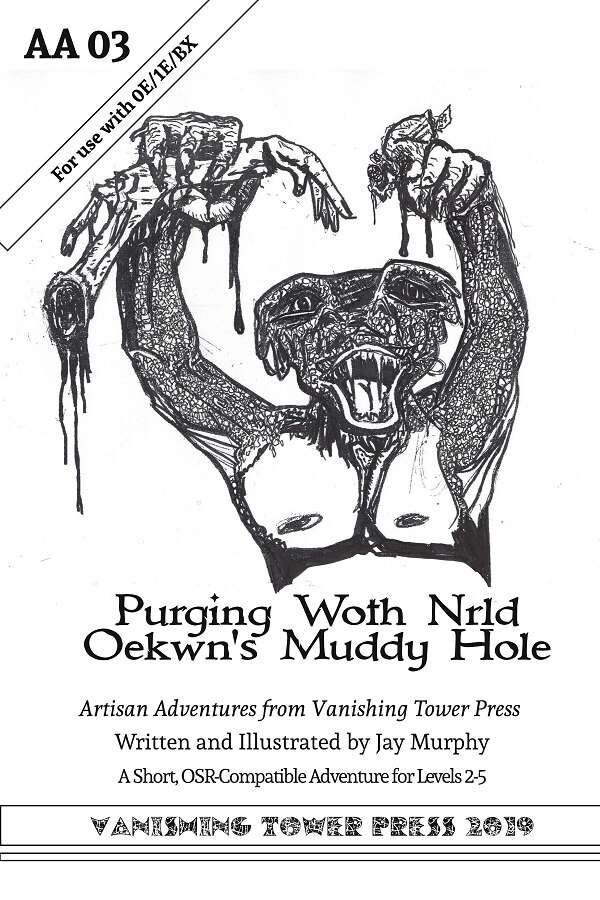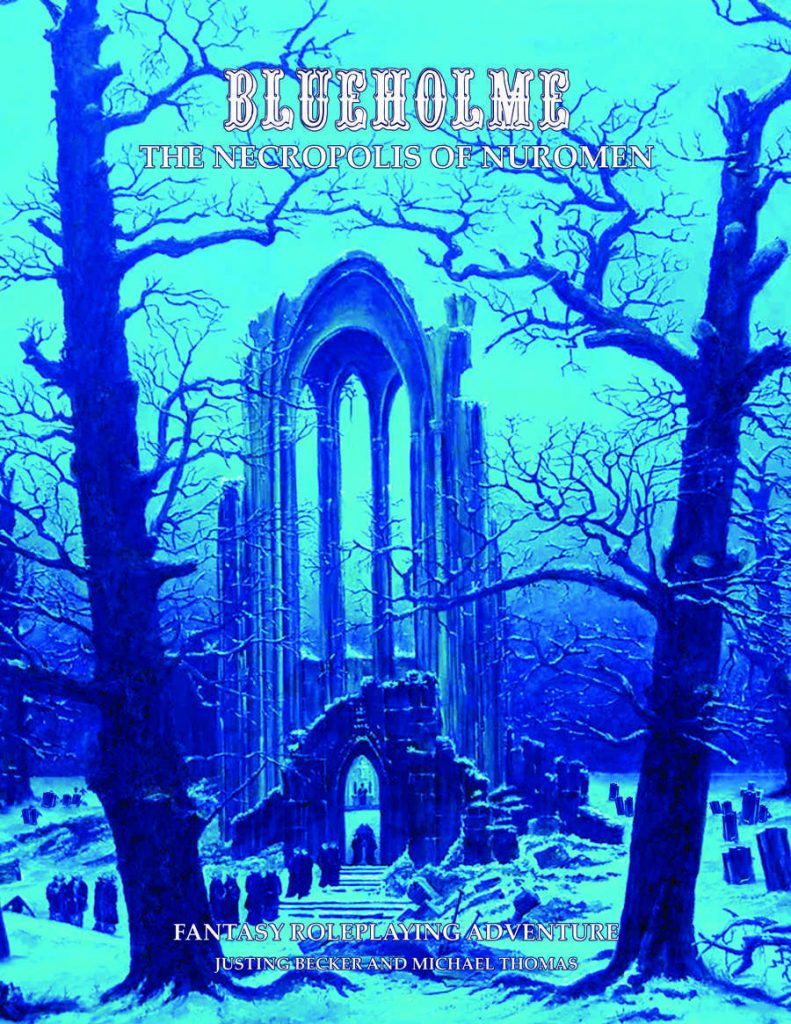
By Justin Becker, Michael Thomas Dreamscape Design Blueholme Level 1
… introduce a group of 1st level characters to the thrills of Underworld exploration as they attempt to unravel they secrets of the evil necromancer’s lair and deal with some bandits, too.
Yes, this line is for you.
This 22 page adventure features a two level dungeon with about thirty rooms. Classic encounters harken back to a time when D&D was fresh. Inconsistencies, and twice as many words as needed, require highlighting and notes to use it as intended.
Sweet cover. And that cover is indicative of the mood created by the adventure. There’s a malaise, or ennui, presented in parts of the adventure. A feeling of weariness. Not in the designers, but an intentional effect in the setting they have created. The cover, the Harry Clarke illustrations (does ANYONE do elves better?) the elves wearying leaving the world, the downfall and doom of the mage Nuroman; the elements combine with the writing style to produce this effect. A magical world of folklore, a weariness in it. It’s done well.
The elements present in the encounters are classical ones. Bottomless pits, rushing underground rivers, skeletal arms wielding swords, or skeletons dicing at a table. There are statues to fuck with and riddles to learn secrets to elsewhere in the dungeon. A sparseness of creatures is balanced though by the wanderer table, and I suspect we could all learn a lesson from this. Is all monsters were lair creatures, and sparsely populated, then the wanderers push the party forward, limiting their careful explorations. Ten creature encounters, about half of which are avoidable and/or triggered by a careless party. There’s a good mix of interactivity and creature encounters, with roleplaying possibilities present in a few and others, as noted, avoidable.
There’s a decent amount of treasure, probably the correct amount for a Gold=XP game, as well as other rewards like stat bonuses and being labeled “Elf friend” by the elves. It’s always good when the party receives accolades when they choose to be good. Magic items are all generic book items and that’s a major disappointment. Not OD&D, but book monsters and book magic treasure means Holmes. Which is what Blueholme is, but it could have been better.
The adventure is plagued by two major issues: excessive trivia and inconsistent details. The later first.
Early in the adventure there are sections describing the forest, the town, the people, the road, and so on. Buried in that is a small section describing a rocky hilltop, ruins, and a black hole in the earth. Then it quickly switches to another rando forest section, leaving those two paragraphs behind. Later on when the dungeon environs proper is reached we get a second, much weaker, description of the area. It has none of the mystery and melancholy of the first section. It doesn’t feel like a writing or editing mistake, but rather a layout issue, lie someone took one of the most effective “dungeon entrance” description and just pasted it in at random earlier. All of that melancholy is lost in the actual dungeon entrance section, which is much more genero ruins oriented. To continue with the entrance, the hole is described as 100 feet deep with last fifty feet choked with rubble. But then, the actual “room one” at the bottom has none of this. It’s not the bottom of a rubble filled pit. It’s a room with a river running through it and you can see the remains of the bridge collapsed in it. And the map shows a room that is, essentially, devoid of rubble. The adventure does this repeatedly, the map and text disconnected and different parts of the text disconnected from each other. Perhaps the two designers did not marry their individual efforts well? Double Doors, mentioned in the text, are single doors on the map. Doors that can’t be closed are represented as standard door symbols. The different elements just don’t make sense together. This, then, is basic consistency checking that an editor can provide. I can be hard on editors, but MOST adventures, even bad ones, can pass some basic consistency checks.
The encounter writing, proper, is full of trivia. I suspect the adventure could be trimmed of at least half its words and the end result would be better for it. I am, frequently, met with a common response to his criticism: “More is better, right?” and it’s cousin “The DM might need it.” No. These are not true. Excessive detail gets in the way of the DM actually running the adventure during the game. It requires a highlighter, notes and a ton of prep work beforehand. If the trivia were NOT present then the DM can focus on the elements of the adventure that actual impact the play of the game. Scanability it much easier. Everyone is happier.
The devil, of course, is in the definition of “Trivia.” What is trivia vs what is needed to run the room, or add flavour to it. Because, of course, we want all of the flavour with none of the trivia. Room 3 is titled “The Old Armoury.” Given that this is a ruin, and that has been properly established, and that it happened in an instant, what would you, gentle reader, then make up about the room, in play, if that’s all you had to go on? The first line of the “The old Armory” is “Here Nuroman’s guards stored their shields, armor and weapons.” The adventure does this over and over again. It will introduce a room and then tell us that the Kitchen is where food was prepared. We know that. It’s a platonic quality of ‘Kitchen.’ This is a classic example of superfluous text that gets in the way. (In fact, I think the classic online example wherein I was introduced to the concept did indeed involve a Kitchen. On rpgsite?) A centipede “that has crawled in through some unknown fissure.” Again, detail unneeded. This is an attempt to explain WHY, and those attempts are (almost)always unneeded. It’s a giant centipede in a dungeon. Vermin need little explanation, except perhaps in extreme circumstances and even then perhaps only if it provides some springboard for the adventure. Coins litter the ground “where they fell from their owners frayed purses.” Worldbuild, history, justifications for what IS. “The magical bones must be defeated before the treasure can be had.” Yes, and while technically correct we do not have a line in each room that says “the door must be opened before someone can walk through it.” Padding, conversational padding. I’m not heartless, throw in some goodies every once in awhile, an aside, or something. But too much and you clog up the text, as is done here.
We do get abstractions though. A scabbard is ‘macabre.’ That’s a conclusion. A good description would make the DM and/or players think “man, that’s macabre!” The challenge is to NOT resort to a conclusion and to communicate ‘macabre’ in a terse manner. This is GOOD detail, the kind that impacts play. The adventure needs more of it. At one point there’s a key hanging on the wall. Only it’s not recognizable as a key, just as the lock it fits is is not recognizable as a lock. That’s it. Nothing more. What does the thing look like? What does the lock look like? Nothing. That’s exactly the sort of thing you SHOULD be spending your word budget on, the things that directly impact the adventure and it’s actual play.
What this all leads to is a foul smelling room, that is then described in two paragraphs as an elegant dining room. Halfway through the third paragraph we’re told it’s befouled with harpy excrement. Well shit, that’s the sort of detail that goes in the first paragraph. Things immediately noticeable should (generally) go higher up in the description where the DMs attention will immediately be focused and thus be able to communicate it to the players. While they interact and ask questions the DM is scanning the next section of text. You can’t make a DM read four paragraphs of text, during the game at the table, before they describe a room. It takes too long and it’s too much to hold in your head at once.
I will make one more Monday Morning Quarterback observation. In one particular room there are skeletons at a table, engaged in a dice game. It you touch the dice they come to life and attack. BORING! They should instead invite the players to dice with them. Then, things could devolve in to a combat. A bit of the ultra-violence is always an option in an RPG, but it’s almost always advisable to have something else BEFORE that, or that leads to that. Plan B, stabbing the fuck out of something/someone, is always an option. It’s the fact that a Plan A also could exist that gives RPG’s some of their charm.
I’m not gonna Regert this, but it’s close. If only the writing could be gotten under control in more places.
This is Pay What You Want at DriveThru with a suggested price of $3. There’s no preview, but it is Pay What You Want, so essentially you could just buy it for $0 to get a preview.
https://www.drivethrurpg.com/product/110292/BLUEHOLMETM-The-Necropolis-of-Nuromen?1892600

